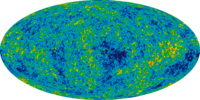
Photo from wikipedia
In order to analyze the mechanism of plasma polarization characteristics and the improvement effect of spectral signal-to-back ratio, the intensity formulas of continuous spectrum and discrete spectrum were derived by… Click to show full abstract
In order to analyze the mechanism of plasma polarization characteristics and the improvement effect of spectral signal-to-back ratio, the intensity formulas of continuous spectrum and discrete spectrum were derived by exploring the path of the radiation spectrum. At the Brewster angle, the model of polarization degree was established based on the measured spectral data to identify the radiation intensity of plasma. The experimental results showed that the polarization characteristics of the background and discrete spectrum were both observed in the plasma spectrum of a copper element, and there were obvious differences in polarization degree and vibration direction. Moreover, cadmium and chromium were used to verify the detection model. It was found that the characteristic signals of the polarization spectrum were more than the effective peaks in laser-induced breakdown spectroscopy, and the variation trend was relatively gentle. The model retained the effective information in the continuum spectrum and fully explored the basic polarization mechanism of plasma. The measured data were not only convenient to observe the characteristic signal peaks of elements, but also greatly improved the recognition effect. This method could extract effective information of illumination plasma under the condition of low incident light intensity and reduce the damage of medium surface, which is a more effective nondestructive testing technology.
Journal Title: Applied optics
Year Published: 2021
Link to full text (if available)
Share on Social Media: Sign Up to like & get
recommendations!